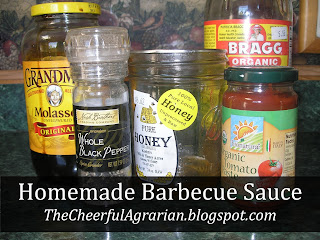I have to give credit for this idea to my Grandma Ada, via my dad. Whenever the topic of planting spinach came up (which, oddly, it did every so often . . .) he would tell me, "Ma always used to just let her spinach go to seed when it got hot out, and then the next spring she'd have the earliest spinach of anybody we knew!"
So last year I tried it. When the spinach plants started bolting in June (that means it starts to get tall and send up a seed stalk, which generally happens when the temperatures start to climb) I didn't pull them up like I normally would (the leaves get bitter, so they're not good to eat anymore) but instead let them do their thing (I did thin them out to about one plant every four feet or so - they'll easily seed an area that large).
They got up to about two feet tall (a few were almost three feet tall) and soon I saw little green balls along the stems:
Later, these little balls turned brown - these were the seeds. I "helped" the spinach a little by pulling off some of the seeds and scattering them around between the plants.
Well, not only did I have the earliest spinach this spring; I also had a second harvest last fall! Bonus!
Spinach is pretty cold-hardy, so even here in Wisconsin, uncovered, I had spinach to eat after the first snowfall (I'm hoping to experiment with cold frames and row covers this fall, which should keep the spinach growing longer into the winter, as well as help it get going earlier in the spring).
I should also note that you will have a LOT of extra plants to thin out - which is a good thing, since you can eat all of those thinnings as "baby greens" before the main harvest is ready, extending your harvest even longer (this just gets better and better!)
I also tried it with my lettuce last year - I didn't get a fall harvest, but I did get more lettuce than I knew what to do with this spring! Bolted lettuce looks different than bolted spinach:
It gets about four feet tall, with tiny yellow dandelion-ish flowers all over the top. The flowers eventually turn white (like dandelion fluff), at which point you can harvest them and store them for next year, or just let them plant themselves (or both! I did a little of each last year. Lettuce seeds are pretty time-consuming to harvest, so I took a few from each plant and left the rest).
Of course, as a general rule you should rotate your garden every year so that you don't wear out a certain garden bed (planting the same type of vegetable in the same spot every year depletes the soil, and also lets plant diseases proliferate). My way of dealing with this is to let the "volunteers" grow in the spring, but then don't let those plants seed out that summer.
Obviously then I won't get any self-seeded plants the next year, so I also put a few lettuce or spinach plants in another bed, and let those new plants go to seed that summer. That way I can have "volunteers" for next year, but still rotate the plants through my garden. As an added bonus, this also extends the harvest, since the second planting usually doesn't bolt quite as early as the first.
You may recall that I'm also trying to
raise some of my own onion sets from seed this year, as well as save my own seed. Here's a picture of the onion flowers in the main garden (I left one about every four feet in the row, and left the rest to make big bulbs for harvest this year):
(If I can keep the stray three-year-olds away, I'd like to plant some of these in the flower garden - I think they're pretty!)
Here are the onions that grew from the seeds I planted this spring:
I left my hand in the picture for size reference - obviously these aren't bulbed out enough for harvest this year, but they should have a great head start next spring, and hopefully get really big for harvest next year!
(By the way, if you want to learn more about saving and using your own seeds, I highly recommend the book Seed Sowing and Saving by Carole Turner. This is great resource with specific information for many different varieties of vegetable, herb, and flower seeds.)
by Carole Turner. This is great resource with specific information for many different varieties of vegetable, herb, and flower seeds.)
This entry was kindly voted a FEATURED POST (!!!) on
Simple Lives Thursday (thanks, everyone!)

 , place:
, place: (this recipe works for slices or spears equally well)
(this recipe works for slices or spears equally well) .
.









